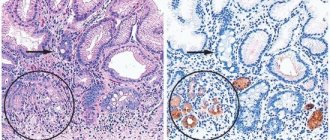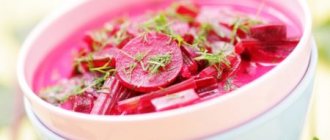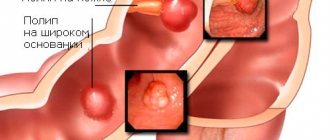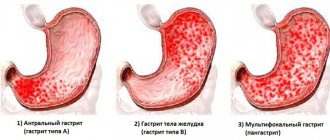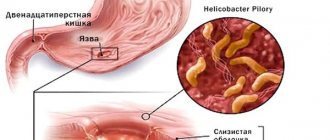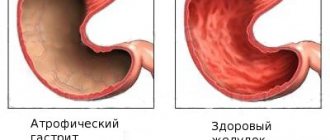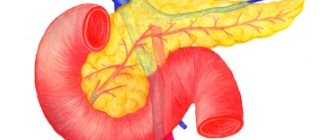Buckwheat porridge is a real salvation for many people with stomach or duodenal ulcers. Many years ago, these unpleasant diseases began to be treated and maintained in the normal condition of patients using a buckwheat diet for the stomach with the addition of other safe foods. It is important to note that such a diet does not cause complications and side effects typical of modern medications that people prescribe for themselves without consulting a doctor.
In case of serious illnesses, it is not enough to start a buckwheat diet for the stomach, but you must first see a specialist. We assure you that not a single gastroenterologist will forbid you to eat buckwheat, and the misconception that buckwheat is a heavy food for the stomach is nothing more than a myth. The benefits of buckwheat for the stomach are obvious: the grain is perfectly digestible, hypoallergenic, does not cause bloating or other unpleasant symptoms, and will never cause abdominal pain after eating, unless, of course, you combine it with fatty meat or spicy gravy.
Beneficial features
One of the features of buckwheat is its high ecological purity, which in itself is beneficial for the body. The ecological purity of buckwheat is associated, first of all, with the fact that the plant is practically not susceptible to pests, which means that it is rarely subjected to chemical treatments. In addition, buckwheat has a unique composition, which allows it to be in third place on the list of the most healthy foods.
It contains organic acids, vitamins, some carbohydrates, macro- and microelements, complete. Buckwheat does not contain gluten, so it can be consumed even if you have celiac disease. And in its kernels you can find B vitamins (pyridoxine, thiamine, niacin, riboflavin), Omega-3, vitamin C, folic and pantothenic acids. In addition, buckwheat contains selenium, manganese, copper, magnesium, calcium, zinc, phosphorus, sodium, and potassium. All this suggests that buckwheat is very beneficial for the stomach.
Buckwheat porridge is useful for gastritis; you just need to follow a few nuances in its preparation and consumption for various types of gastritis.
Popular recipes
For people suffering from gastritis with high acidity and for the overall health of the body, the following recipe is used in folk medicine.
- Method 1. The first stage consists of frying the cereal in a dry frying pan until dark brown. After cooling the product, it is ground in a coffee grinder to a fine powder. You can also use a mortar and grind the grains by hand. It is recommended to eat a pinch of powder three times a day before meals.
- Method 2. This recipe is considered universal. Cereals in the amount of 1 tbsp. l. sorted out, placed in a suitable container and filled with the same volume of clean water. To get the finished product in the morning, preparation begins in the evening. Before breakfast, take the swollen porridge on an empty stomach. The procedure is repeated for two weeks.
Buckwheat is allowed for many diseases. You can use it to prepare not only porridge, but also soups, cutlets, meatballs, casserole, cabbage rolls.
Gastritis requires close attention to what is included in the daily diet. Many products will have to be abandoned, and the norm of some will have to be extremely reduced. But if patients include buckwheat in their menu, their condition will improve faster. Regular consumption of buckwheat is also considered a reliable means of preventing gastritis in adults and children.
How to cook buckwheat correctly
Diet for gastritis is one of the mandatory components of the treatment of the disease, since a damaged stomach cannot fully cope with the function assigned to it.
The task of dietary nutrition is not only to be gentle on the digestive organs, but also to supply the body with all useful elements. Buckwheat and dishes made from it fully fulfill all these requirements.
With gastritis, most often there is an imbalance in the acid balance, so dishes with different types of gastritis from buckwheat need to be prepared differently. It is allowed to use it without restrictions only during the period of remission. During an exacerbation of the disease, you can eat buckwheat porridge, but it is advisable to boil it, first crushing it, to a semi-liquid consistency. And after the attack of exacerbation is relieved, you can return to the previous, not so gentle, cooking option.
There are general rules for preparing buckwheat that must be followed to make eating buckwheat most beneficial:
- Buckwheat should be cooked in water, since milk and cream can reduce the degree of digestibility of the product;
- It is better to eat cooked buckwheat with a small piece of boiled lean fish or meat;
- for gastritis and pancreatitis, it is recommended to eat boiled or baked vegetables along with buckwheat (it is not recommended to add spices or seasonings to such dishes);
- Buckwheat dishes should be eaten exclusively warm;
- for good absorption and to avoid side effects such as irritation of the mucous membrane, it is recommended to pre-grind the porridge (for this you can use a blender or rub it through a sieve);
- for cooking, it is better to purchase grains that are not overcooked; it is better to purchase thermally untreated grains, since such a product contains more useful substances and microelements.
For gastritis with high acidity, buckwheat is consumed in a well-cooked form, helping not only to supply the human body with useful substances, but also not to irritate the gastric mucosa. For gastritis with reduced secretion or atrophic gastritis, there is a different way to consume buckwheat. There are also specific uses during periods of exacerbation of the disease or stomach ulcers.
The following properties also give buckwheat special value:
- contains a large amount of vegetable protein that nourishes the body and supplies it with energy;
- the presence of vitamin PP, which promotes the healing of the gastric mucosa and restoration of its integrity;
- almost complete digestion of cereals;
- low amount of carbohydrates, which is good for diabetics;
- Thanks to the high percentage of vitamin P, buckwheat dishes have an anti-inflammatory effect, helping the body fight various infections.
When gastritis with high acidity is diagnosed, it is recommended to prepare the following dishes from buckwheat:
- the first is soup in vegetable broth made from potatoes and carrots with the addition of separately cooked buckwheat. You can season the soup with butter or vegetable oil, low-fat cream and dill;
- the second is buckwheat porridge, boiled in water, which is excellent as a side dish for steamed cutlets or meatballs made from lean meat, for stewed or oven-baked chicken and rabbit meat, and goes well with vegetable caviar, fresh tomato salad and boiled vegetables ;
- buckwheat milk porridge is also welcome in the diet for gastritis;
- In addition, buckwheat cooked until half cooked is mixed with minced chicken or beef, carrots, onions, egg yolk, and salt are added in a small amount. The resulting mass is formed into cutlets and baked in the oven with butter;
- By grinding pre-roasted unprocessed cereal into powder in a coffee grinder, it can be used to make flatbreads, added to cutlets, or eaten raw with food. You can consume several teaspoons of buckwheat flour daily, washing it down with water or compote.
All these dishes are perfectly digestible by the stomach.
Buckwheat for gastritis with increased secretion can be prepared in different ways and combined with various products, but the following rules must be followed:
- when preparing soups, use only low-fat broths;
- To season the soup, you cannot fry it; it is recommended to use vegetable oil or low-fat cream instead;
- cook porridge in water, not milk, leaving a little water after cooking;
- The cereal should be well boiled; it is better to overcook it a little than to leave it hard - this can harm the body.
For gastritis with high acidity, buckwheat can be not only a complete dish, but also a medicine for relieving heartburn. To do this, it must be fried without oil in a dry frying pan, turned into powder using a coffee grinder and consumed when heartburn bothers you in the amount of one pinch, washed down with warm milk or plain water.
It is recommended to consume raw buckwheat on an empty stomach for 2 weeks. For this in the evening, 1 tbsp. A spoonful of buckwheat is poured with water in a 1:1 ratio, and eaten in the morning half an hour before breakfast.
Cooking options
For gastritis, it is better to consume buckwheat in the form of crumbly, liquid or viscous porridge with water or milk. You can add butter, a little sugar, dried fruits to it. The crumbly version is a complete side dish for boiled fish and steamed cutlets. But you shouldn’t use it too often, giving up other cereals. It is important to keep your diet varied.
If you are sorely short of time, cook buckwheat in a slow cooker. We tell you how to do this:
- Rinse the cereal until clean, cut the onion into rings, and grate the carrots.
- Lightly grease the multicooker mold with vegetable oil, put buckwheat with cooked vegetables there, you can add pieces of lean meat, and add salt.
- Fill with water until it covers the contents and is about 2 fingers higher. Set the “Pilaf” or “Stew” mode (15-20 minutes). And as a result, you will get a tender, crumbly porridge with soft meat and aromatic vegetables.
The dish simply melts in your mouth. Due to the high pressure, the cereal quickly boils, but at the same time retains its nutritional value.
Important! If you add little water, the buckwheat will be tough. The main thing is not to make mistakes with the volume of liquid.
Kissel
From finely ground buckwheat flour you can prepare an enveloping and very healthy buckwheat jelly. We offer a step-by-step recipe:
- Grind the finished group in a coffee grinder.
- For 3 tablespoons, take 300 ml of water (boiling water).
- Gradually add buckwheat powder to boiling water, cook over low heat until tender, stirring constantly.
It is better to consume this jelly on an empty stomach, so that the product has an enveloping effect on the mucous membrane and prevents irritation during the day. Prepare new jelly every day.
Buckwheat for gastritis with low acidity
With hypoacid gastritis, there is a lack of food enzymes for food processing. The diet for this form of gastritis includes foods that help stimulate gastric juice, without irritating the mucous membrane or overloading the stomach.
With this form of gastritis, buckwheat must be included in the diet, but porridge from it must be prepared sufficiently viscous, not crumbly, so that it is easy for the stomach to cope with it.
For gastritis with reduced secretion, you can prepare the following dishes:
- soups with buckwheat in meat or mushroom broth. They help improve digestion. You can add potatoes, carrots, onions, and herbs to them;
- porridge. They are seasoned with a small amount of cream or vegetable oil (pumpkin, sesame, olive);
- buckwheat porridge as a side dish. With low acidity, mushrooms, lean meat (lightly fried and then stewed), raw vegetables, sour gravies and sauces are allowed in the diet. Porridge with such additives will not only suppress hunger, but also replenish the body with useful substances.
When consuming cereals, you must adhere to your rules:
- prepare soups based on mushroom or meat, but not fatty broths;
- use vegetable oil rather than butter as a dressing for porridges;
- You can use mushrooms or vegetables as a side dish;
- It is good to serve buckwheat dishes with uzvar, jelly, compotes, and juices.
You can cook cereal not only by boiling it, but also by using another, non-thermal method of preparing buckwheat, especially when you want to get the maximum amount of valuable and nutritious elements from the dish. For this, 3 tbsp. spoons of buckwheat are brewed with 300 ml of boiling water, cover with a lid and leave overnight (instead of water, you can use hot milk in the same proportion).
The finished buckwheat is ground to a semi-liquid state in a blender. Each time they prepare a new portion of this porridge. If it is difficult to eat buckwheat uncooked, you can reduce the portion. This dish should be consumed every day for two weeks.
Raw buckwheat with kefir is also good for gastritis with low acidity. Low-fat kefir itself is an essential component of a diet for gastritis with reduced gastric secretion, since it, like other fermented milk products, improves food digestion, increases stomach acidity, relieves irritation, and normalizes the level of acid-base balance.
At the same time, buckwheat with kefir restores the gastric mucosa and suppresses the growth of pathogenic bacteria. To prepare such a dish, pour kefir over the ground cereal and wait for it to swell. This mixture can even be eaten cold.
If your stomach hurts
If your stomach hurts after eating buckwheat porridge, pay attention to the quality of cooking. It is not recommended to pre-fry the grains. You should also not season buckwheat with fried vegetables or serve fatty meats with it, especially fried meats.
If pain occurs from eating regular buckwheat porridge, it is recommended to drink an infusion of flaxseeds before meals. It protects the mucous membrane well from possible irritation by food. Try drinking a little kefir on an empty stomach, and after 30-40 minutes eat buckwheat porridge.
Among medications, omeprazole taken half an hour before meals will reliably protect the stomach. Also, when heartburn occurs, antacids - Hefal, Almagel - help. Do not forget that all medications can only be used on the recommendation of a doctor.
Buckwheat for exacerbation of gastritis
During the acute period of the disease, a person often feels severe pain and suffers from vomiting. In the first days, the patient is advised to refuse food, replacing it with rosehip infusion, weak sweetened tea or table water. On the 2-3rd day, you can introduce viscous soups and liquid porridges into the diet, but buckwheat porridge should be viscous, it has an enveloping effect on the inflamed mucous membrane.
Eating any food must be portioned; overeating, including buckwheat porridge, is not allowed. The product is eaten only in grated or highly crushed form.
Buckwheat diet - review
On a buckwheat diet you can easily lose 7-12 kilograms in one to two weeks.
Buckwheat gives you a feeling of satiety and at the same time cleanses the body. Using such a diet, you can not only lose weight, but also get rid of dermatological problems. How to cook buckwheat: Pour about 2-2.5 cups of boiling water over one glass of cereal and leave overnight. You simply drain the excess water in the morning. There is no need to cook buckwheat. The diet is designed for one to two weeks, then you should take a break for at least a month. When adhering to this diet, you should follow the following rules: eat buckwheat as much as you like, but without spices, sauces and lightly salted; The porridge should be eaten with 1% fat kefir. You will need one packet of kefir per day. And if you don’t like kefir, then try mixing it with buckwheat, it will turn out very tasty and new sensations will appear; It is better to drink more water - from 1.5 liters to 3 liters (we count the liquid together with kefir); any drinks are suitable and in any quantities, preference is given to low-calorie drinks (tea and coffee are not prohibited); fruits are allowed, but in limited quantities (for example, one or two apples per day or a couple of peaches, but it is advisable to eat them separately); It is better not to eat anything four to six hours before bedtime. If you are really hungry, then you can drink half a glass or a glass of kefir diluted in half with water half an hour or an hour before bedtime; You can eat low-calorie yoghurts, 50-150 g per day; alcohol is undesirable, but if you absolutely cannot refuse, then it is better to limit yourself to good dry or semi-sweet wine, 100-200 grams will not affect the diet if it is no more than once a week; be sure to take multivitamins; After two weeks you need to take a break. This is necessary, firstly, so that the body does not get used to the diet, and secondly, it is quite strict, so it is necessary to diversify it. It is recommended to be on any diet for no more than 14 days in a row and for at least seven days on a diet with buckwheat. You can repeat after two weeks. Ideally, the entire diet consists of buckwheat and a packet of kefir per day and an unlimited amount of plain or mineral water. All other additions are improvisation, which is not prohibited. The main thing is that it gives results. Even if you had to break your diet, it’s okay, the next day continue as if nothing had happened, but it’s better not to allow such excesses to happen again. After you finish the diet, eat in moderation to avoid gaining weight again quickly. The main thing is not to overeat, do not eat at night and do not allow yourself to go hungry. Stomach hurts after eating buckwheat
Question answer
I really like porridge, especially buckwheat, but I was diagnosed with erosive gastritis. Is buckwheat contraindicated for me or not?
For erosive gastritis, the diet prescribed is quite strict, but among the permitted foods there are porridges, including buckwheat. It is better to cook it in water or milk diluted 1:1 with water.
References: med.vesti.ru/articles/zabolevaniya/dieta-pri-gastrite-zheludka/ https://www.kp.ru/guide/chto-mozhno-est-i-pit-pri-gastrite.html Nutrition for gastric diseases, Ilya Melnikov 2009. Notes from the author of the article, based on personal experience. This material is purely subjective and is not a guide to action. Only a qualified specialist can determine an accurate diagnosis and prescribe treatment.
Causes of pressing pain in the stomach and methods of treating it
Unfortunately, due to the frantic pace of life of the modern population, gastrointestinal ailments are the most common problems that bring discomfort and pain.
Today it is rare to meet a person who has never taken medications for problems with the stomach, intestines, liver, etc. Pressing pain, which is localized in the stomach, usually worsens after eating food. This is understandable, because after filling the stomach begins to put pressure on the front wall, thereby supporting the diaphragm.
So how can you establish a cause-and-effect relationship and understand what disease led to the pain and how you can get rid of it? Further in the article we will try to tell you what the nature of the pain will tell you, how to correctly diagnose and treat it, because stomach pain is not always a sign of a gastrointestinal tract illness.
What does the nature of the pain in the stomach indicate?
The nature of pain in the stomach
First of all, it is worth highlighting that it is by the nature of the manifestation of pain that the preliminary cause of the disease can be established. And so, let's now take a closer look at the nature of the appearance of pressing pain. For example, pressing sensations in the stomach area very often bother expectant mothers, especially pronounced towards the middle of the 2nd – end of the 3rd trimester. But there is an explanation for this.
By this period, the uterus (which has already significantly increased in size) affects the diaphragm, when the stomach is full, it rises, after which painful sensations form behind the sternum. If a pressing feeling appears in the epigastric region, this may be caused by pathological malfunctions in the functioning of systems and organs that are not part of the digestive system. Such ailments can be called:
- Pneumonia.
- Malfunctions of the heart and vascular system.
- Diaphragm spasm.
It is also worth highlighting ailments of the digestive system that can provoke a feeling of pressure, namely:
- Peptic ulcer of the stomach and duodenum.
- Pancreatitis.
- Pathological changes in the liver, bile and its ducts.
- Oncology (stomach).
Pressing pain in the stomach
It is in the presence of such pathologies of the stomach and gastrointestinal tract that upon completion of eating (after 45-90 minutes) gastric pressure increases as a result of digestion, which leads to pain. Also, another cause of pain and increased pressure in the stomach cavity can be an inflammatory process in the cecum and other intestinal parts.
But do not immediately panic if you notice discomfort in the form of increased pressure in the stomach, because such manifestations of pain do not always indicate illness. A feeling of squeezing in the stomach can occur as a result of:
- Excessive food consumption.
- The body's response to stress or a conflict situation.
- Driving fast, flying on an airplane, going on amusement rides, etc.
- Illness caused by infection.
- Allergic reaction of the body.
- Excessive physical activity.
We will tell you later in the article how to correctly diagnose stomach pain in the form of high blood pressure and how to get rid of it.
Methods for diagnosing pressing pain
Pressing pain in the stomach
It is in the presence of such pathologies of the stomach and gastrointestinal tract that upon completion of eating (after 45-90 minutes) gastric pressure increases as a result of digestion, which leads to pain. Also, another cause of pain and increased pressure in the stomach cavity can be an inflammatory process in the cecum and other intestinal parts.
But do not immediately panic if you notice discomfort in the form of increased pressure in the stomach, because such manifestations of pain do not always indicate illness. A feeling of squeezing in the stomach can occur as a result of:
- Excessive food consumption.
- The body's response to stress or a conflict situation.
- Driving fast, flying on an airplane, going on amusement rides, etc.
- Illness caused by infection.
- Allergic reaction of the body.
- Excessive physical activity.
We will tell you later in the article how to correctly diagnose stomach pain in the form of high blood pressure and how to get rid of it.
Methods for diagnosing pressing pain
If a person is bothered by pressing pain in the stomach cavity, the first thing to do is to find the root cause that caused the formation of such discomfort. As a rule, diagnosis should begin with a general examination of the patient, during which the attending physician should listen to the patient's complaint about what is bothering him and draw up an overall clinical picture based on the information received. At the next stage you will need to undergo the following tests:
- General blood analysis.
- Analysis of urine.
- Ultrasound examination of the gastric cavity.
If the doctor determines that the cause of the pain is an ailment of the digestive system, additional examinations of the patient will be required, namely:
- FGS.
- Taking a sample of the patient's blood for the presence of sugar and enzymes.
- Blood sampling to determine the presence of Helicobacter pylori infection.
- Testing stool for dysbacteriosis.
Dietary food for pressing pain in the stomach
To minimize the intensity of pressing pain, until a doctor makes an accurate diagnosis, you need to switch to a dietary diet as quickly as possible, the goal of which is to relieve the stomach as much as possible from excessive stress.
The table below shows the main categories of prohibited and permitted products, from which you can create a gentle, complete and varied menu for every day.
| Pastries made from butter dough. | Diet biscuits, crackers. |
| Sweets (especially chocolate, fatty creams). | A little honey, marshmallows, marshmallows |
| Spices and other dressings for dishes. | Homemade sauce |
| Broths made from fatty meats and fish. | Broths from dietary meats and seafood |
| Alcohol, soda. | Dairy and fermented milk products, herbal infusions, jelly |

